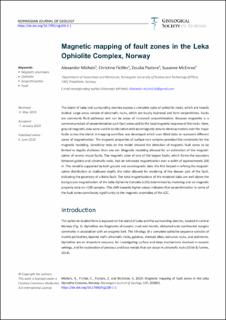| dc.contributor.author | Michels, Alexander Christopher | |
| dc.contributor.author | Fichler, Christine | |
| dc.contributor.author | Pastore, Zeudia | |
| dc.contributor.author | McEnroe, Suzanne | |
| dc.date.accessioned | 2021-03-26T13:07:47Z | |
| dc.date.available | 2021-03-26T13:07:47Z | |
| dc.date.created | 2020-07-03T10:13:41Z | |
| dc.date.issued | 2020 | |
| dc.identifier.citation | Norwegian Journal of Geology. 2020, 100 . | en_US |
| dc.identifier.issn | 2387-5844 | |
| dc.identifier.uri | https://hdl.handle.net/11250/2735758 | |
| dc.description.abstract | The island of Leka and surrounding skerries expose a complete suite of ophiolitic rocks, which are heavily faulted. Large areas consist of ultramafic rocks, which are locally hydrated and form serpentinites. Faults are commonly fluid pathways and can be areas of increased serpentinization. Because magnetite is a common product of serpentinization such fault zones add to the local magnetic response of the rocks. Here, ground-magnetic data were used in combination with aeromagnetic data to develop models over the major faults across the island. A mapping workflow was developed which uses tilted slabs to represent different zones of magnetization. The magnetic properties of surface-rock samples provided the constraints for the magnetic modeling. Sensitivity tests on the model showed the detection of magnetic fault zones to be limited to depths shallower than one km. Magnetic modeling allowed for an estimation of the magnetization of several major faults. The magnetic zone of one of the largest faults, which forms the boundary between gabbro and ultramafic rocks, had an enhanced magnetization over a width of approximately 200 m. The model is supported by both ground and aeromagnetic data: the first helped in refining the magneti- zation distribution at shallower depth, the latter allowed for modeling of the deeper part of the fault, indicating the geometry of a listric fault. The total magnetizations of the modeled slabs are well above the background magnetization of the Leka Ophiolite Complex (LOC) determined by modeling and on magnetic property data on >500 samples. This shift towards higher values indicates that serpentinization in some of the fault zones contributes significantly to the magnetic anomalies of the LOC. | en_US |
| dc.language.iso | eng | en_US |
| dc.publisher | Norsk Geologisk Forening | en_US |
| dc.rights | Navngivelse 4.0 Internasjonal | * |
| dc.rights.uri | http://creativecommons.org/licenses/by/4.0/deed.no | * |
| dc.title | Magnetic mapping of fault zones in the Leka Ophiolite Complex, Norway | en_US |
| dc.type | Peer reviewed | en_US |
| dc.type | Journal article | en_US |
| dc.description.version | publishedVersion | en_US |
| dc.source.pagenumber | 27 | en_US |
| dc.source.volume | 100 | en_US |
| dc.source.journal | Norwegian Journal of Geology | en_US |
| dc.identifier.doi | 10.17850/njg100-1-1 | |
| dc.identifier.cristin | 1818377 | |
| dc.description.localcode | © Copyright the authors. This work is licensed under a Creative Commons Attribution 4.0 International License | en_US |
| cristin.ispublished | true | |
| cristin.fulltext | original | |
| cristin.qualitycode | 1 | |

